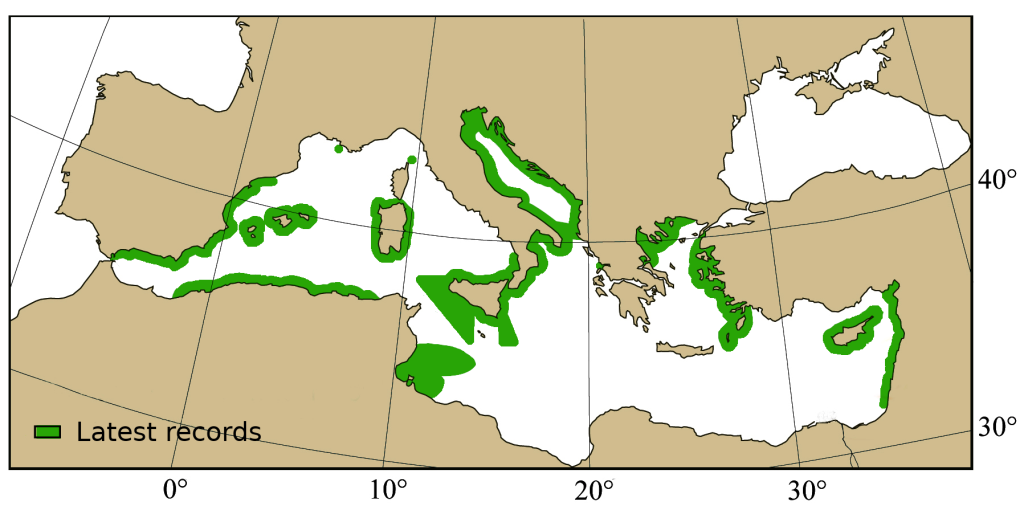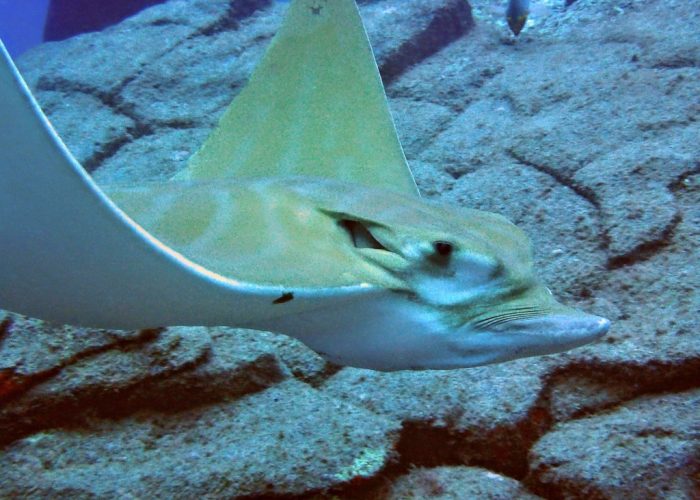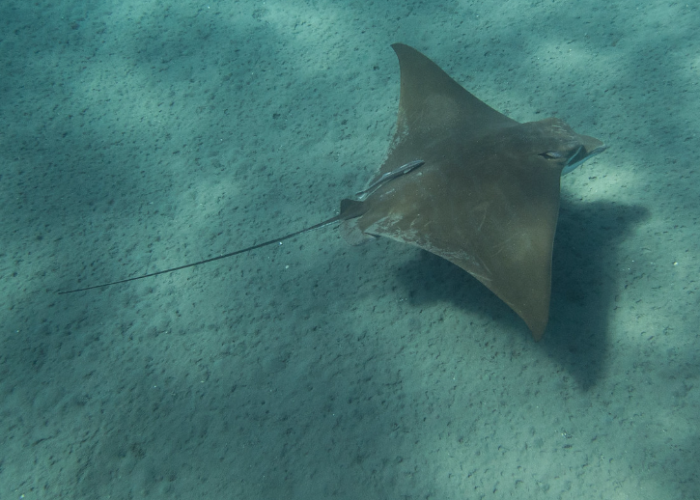Aetomylaeus bovinus
- Common name : Bull ray, Duckbill eagle ray
- Order: Myliobatiformes
- Family: Aetobatidae
- Synonyms: Myliobatis bovina, Pteromylaeus bovina, Pteromylaeus bovinus
- Misidentifications: Myliobatis aquila
Short description
Large batoid. Head thick, distinct from disk, forming a rostrum like a broad projection. Front part of the head is similar to a duck’s bill. Upper or lower jaw with 7 rows of flat teeth. Two large eyes positioned laterally. Pectoral rhombic disc with angular corners strongly curved. Dorsal fin before pelvic fin tips. No caudal and anal fin. Thin tail, like a whip.
Color: Light brown dorsal surface in adults, with 7-8 stripes transverse blue-gray in juvenile specimens. White ventrally.
Measurements:
- Disk width (DW): 60-100 cm (max 250 cm)
- Total length (TL): 76-90 cm (max 294 cm)
- Weight: 12-30 kg (max 116 kg)
Swimming pattern: Oscillatory locomotion.
Biology / Ecology
Feeds on bottom-living crustaceans and mollusks (mussels, oysters and gastropods). Often cause damage to clam and oyster farms.
Behavior: Sometimes found in small groups.
Reproduction: Viviparous (aplacental viviparity with histotrophy). Size at maturity (DW): 90-100 cm female, 80-95 cm male. Gestation period: 6-8 months. Juveniles per litter: 3-7. Size at birth (DW): 22-45 cm.
Habitat: Demersal and semi-pelagic in estuaries, lagoons and on the continental shelf, occurring in tropical and warm temperate coastal waters, occasionally offshore. Inhabits both benthic and pelagic environments at depth between 10 and 500 m, but also observed close to the surface of the water.
This species often causes damage to clam and oyster farms.
Distinguishing characteristics
- Snout like a duck’s bill.
- Pectoral disc with angular corners strongly curved.
- Origin of the dorsal fin in front of the pelvic fin tip.
- 7-8 stripes transverse blue-gray in juvenile specimens.
Myliobatiformes: No caudal and anal fin. Thin tail like a whip.
Aetobatidae: Large batoid. Moderately long fleshy rostral lobe connecting to the head at eye level. Caudal sting behind the dorsal fin.
Distribution
Worldwide: Atlantic from Portugal to South Africa.
Mediterranean: Presence in the southern Mediterranean (formerly Morocco and Algeria, currently also northern Tunisian areas), Aegean Sea, Greek waters, Dodecanese waters, Adriatic Sea, Iskenderun Bay (Turkey), Israel. Absent in the Black Sea, but one record in the Marmara Sea. Hypothesis of a seasonal migration of the species from Sicily.
- Occurence : Rare.
- Latest records: Cyprus (2018-2022), Montenegro (2019), Sicily (2018), Tunisia (2017), Spain (2016), Adriatic Sea (2013), Turkey (2012), Grece (2010), Algeria (2003), Syria (2003), Balearic Island (2002).

Any recent observation not on the map?
Contact us!
Conservation
Threats: Bycatch in industrial and artisanal fisheries (including trawl, gillnet, set net, tangle net and trammel net). Human consumption (but not considered as economically commercially important species).
Protection level:
- Global: Critically Endangered (IUCN 2021, last assessment: 2020)
- Mediterranean: Critically Endangered (IUCN 2016, last assessment: 2016)
- Europe: Critically endangered (IUCN 2015, last assessment: 2014)
Key references
- Başusta N., Aslan E. 2018. Age and growth of bull ray Aetomylaeus bovinus (Chondrichthyes: Myliobatidae) from the northeastern Mediterranean coast of Turkey. Cahiers de Biologie Marine 59: 107‑114.
- Bilecenoğlu, M. 2019. First record of Aetomylaeus bovinus (Geoffroy St. Hilaire, 1817)(Elasmobranchii: Myliobatidae), from the Sea of Marmara. Journal of the Black Sea/Mediterranean Environment 25(2): 182-187.
- Carpentieri P., Nastasi A., Sessa M., Srour A. 2021. Incidental catch of vulnerable species in Mediterranean and Black Sea fisheries – A review. General Fisheries Commission for the Mediterranean. Studies and Reviews 101: I-317.
- Follesa M. C., Marongiu M. F., Zupa W., Bellodi A., Cau A., Cannas R., Colloca F., Djurovic M., Isajlovic I., Jadaud A., Manfredi C., Mulas A., Peristeraki P., Porcu C., Ramirez-Amaro S., Salmerón Jiménez F., Serena F., Sion L., Thasitis I., Cau A., Carbonara P. 2019. Spatial variability of Chondrichthyes in the northern Mediterranean. Scientia Marina 83(S1): 81-100.
- Geraci M.L., Ragonese S., Scannella D., Falsone F., Gancitano V., Mifsud J., Gambin M., Said A., Vitale S. 2021. Batoid Abundances, Spatial Distribution, and Life History Traits in the Strait of Sicily (Central Mediterranean Sea): Bridging a Knowledge Gap through Three Decades of Survey. Animals 11(8): 2189.
- Gerovasileiou V., Akyol O., Al-Hosne Z., Rasheed R. A., Atac E., Bello G. et al. 2020. New records of rare species in the Mediterranean Sea (May 2020). Mediterranean Marine Science 21(2): 340-359.
- Giovos I., Spyridopoulou R. A., Doumpas N., Glaus K., Kleitou P., Kazlari Z., Katsada D., Loukovitis D., Mantzouni I., Papapetrou M., Papastamatiou Y.P., Moutopoulos D. K. 2021. Approaching the “real” state of elasmobranch fisheries and trade: A case study from the Mediterranean. Ocean & Coastal Management 211: 105743.
- Giovos I., Serena F., Katsada D., Anastasiadis A., Barash A., Charilaou C., Hall-Spencer J.M.,Crocetta F.,Kaminas A., Kletou D, Maximiadi M., Minasidis V., Moutopoulos D.K., Aga-Spyridopoulou R.N., Thasitis I., Kleitou P. 2021. Integrating literature, biodiversity databases, and citizen-science to reconstruct the checklist of Chondrichthyans in Cyprus (Eastern Mediterranean Sea). Fishes 6(3): 24.
- Mulas A., Bellodi A., Carbonara P., Cau A., Marongiu M.F., Pesci P., Porcu C., Follesa M.C. 2021. Bio-ecological features update on eleven rare cartilaginous fish in the Central-Western Mediterranean Sea as a contribution for their conservation. Life 11(9): 871.
- O’Keefe M., Bengil EG., Palmer JL, Beton D, Çağlar Ç., Godley B.J, Özkan M., Snape R.T.E., Broderick A.C. 2023. Diversity and distribution of elasmobranchs in the coastal waters of Cyprus: using bycatch data to inform management and conservation. Front. Mar. Sci. 10: 1181437.
- Ordines F., Massutí E., Moranta J., Quetglas A., Guijarro B., Fliti K. 2011. Balearic Islands vs Algeria: two nearby western Mediterranean elasmobranch assemblages with different oceanographic scenarios and fishing histories. Scientia Marina 75(4): 707-717.
- Soldo A., Lipej L. 2022. An Annotated Checklist and the Conservation Status of Chondrichthyans in the Adriatic. Fishes 7(5): 245.
- Taylan B., Bayhan B., Sağlam C., Babaoğlu A.Ö., Kara A. 2022. The Length-Weight Characteristics of Five Elasmobranch Species (Pisces: Chondrichthyes) from Izmir Bay (Aegean Sea Coast of Turkey): Spring 2018. Turkish Journal of Agriculture-Food Science and Technology 10(2): 368-373.



